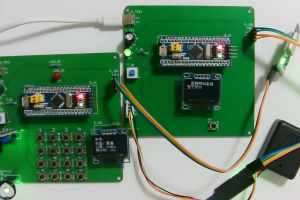设计说明书
总字数:13000+
随着人民生活水平的日益提高,人们越来越来重视自己的身体健康。医院服务质量关乎患者的切身利益,而病房呼叫系统作为护理站医护人员与病房患者联系的主要手段,直接体现医院的服务水平,因此,一个好的病房呼叫系统在一定程度上能够减少医患矛盾的发生。目前大多数医院已经配置相应的病房呼叫系统,现有基于有线通信的病房呼叫系统有着自身的优点,但是,患者较多的科室往往需要临时增加床位,甚至需要患者坐在医院过道板凳上进行输液,现有基于有线通信方式的病房呼叫系统不能解决这种情况。本文使用ZigBee技术实现病房无线呼叫系统的信号传输,作为对现有基于有线通信方式的病房呼叫系统的扩展,解决上述问题。本文以病房无线呼叫系统为研究背景,详细探讨ZigBee 网络协议栈每层所提供的功能,最后在ZigBee开发平台下,讲述如何使用ZigBee技术开发一个实际的项目。该设计可以实现以下功能:用户可以通过4*4矩阵键盘,可以输入病床号(位数不限),病床分为普通病房(按键“A”)和重症病房(按键“B”),当普通病房短按“#”键时为普通呼叫,长按“#”键时为紧急呼叫;重症病房呼叫都为紧急呼叫;当按下“#”键呼叫后,LED灯常亮,当医护人员利用主机按下“知晓”键后,灯变成闪烁,当医护人员过来检查后,按下“C”键,灯熄灭;通过红外避障管检测手是否放在心率传感器上,如果放在心率传感器则实时监测病人心率,当心率异常时,进行紧急呼叫;数据通过通过OLED显示;主机和从机通过zigbee收发数据。当病人有呼叫时,OLED显示病床号和普通呼叫还是紧急呼叫,如果多个病人同时呼叫,按照先后顺序显示;通过TTS语音模块循环播报病床号和普通呼叫还是紧急呼叫;医护人员可按下“应答”键,播报停止(OLED所有内容清除)。
关键词:病房无线呼叫系统:ZigBee;语音播报;单片机技术
China is a large agricultural country, agricultural development and social and economic development are inseparable, in recent years, the application of the Internet of things and sensor technology is increasingly extensive, the combination of information technology and traditional industries has been an inevitable trend, with greenhouse as the representative of the facility agriculture also ushered in a new development opportunity. The traditional extensive greenhouse agricultural production mode has been far from meeting the needs of The Times. This paper designs a greenhouse monitoring system based on the Internet of Things on the basis of the research status of greenhouse monitoring system. The system mainly uses Bluetooth and sensor technology to realize the remote monitoring of environmental data in the greenhouse and the control function of the executive mechanism, so that the crops in the greenhouse can grow in a suitable environment. The main contents of the study are as follows:
(1) Research on key technologies of the system and design of the overall scheme. According to the actual needs of greenhouse users for automatic control, the key technologies are studied and the overall scheme of the system is designed in combination with the Internet of Things technology.
(2) System hardware design. According to the system hardware structure, the Bluetooth wireless sensor network, the main control module and the hardware circuit of the actuator are designed respectively.
(3) System software design, which includes three parts: Bluetooth wireless sensor network software design, main module software design and sub-executive design. First of all, the environmental data in the greenhouse is obtained through the Bluetooth wireless sensor network, including the environmental temperature and humidity in the greenhouse, soil moisture, CO2 concentration, and light intensity, and then transmitted wirelessly to the manager’s mobile phone. Finally, the environmental data in the greenhouse is visualized through the greenhouse monitoring platform. The test data can be automatically adjusted according to the parameters set by the manager, so that these test parameters in the greenhouse are within the range suitable for the current crop growth.
(4) System construction and testing. After completing the software and hardware design of the system, a model was built in the laboratory to simulate the internal environment of the greenhouse, and the functions of Bluetooth wireless sensor network and greenhouse monitoring platform were tested respectively.
Key words: Internet of Things; Bluetooth; Greenhouses; Measure and control. With the improvement of people’s living standards, people pay more and more attention to their health. The quality of hospital service is related to the vital interests of patients, and the ward call system, as the main means for the medical staff to contact the patients in the ward, directly reflects the service level of the hospital. Therefore, a good ward call system can reduce the occurrence of doctor-patient conflicts to a certain extent. At present, most hospitals have configured the corresponding ward call system, and the existing ward call system based on wired communication has its own advantages. However, departments with more patients often need to temporarily add beds, or even require patients to sit on the bench in the hospital aisle for infusion. The existing ward call system based on wired communication can not solve this situation. This paper uses ZigBee technology to realize the signal transmission of ward wireless call system, as an extension of the existing ward call system based on wired communication mode, to solve the above problems. Based on the research background of ward wireless call system, this paper discusses the functions provided by each layer of ZigBee network protocol stack in detail, and finally describes how to develop a practical project using ZigBee technology under the ZigBee development platform. The design can realize the following functions: the user can enter the bed number (the number of digits is not limited) through the 4*4 matrix keyboard, the hospital bed is divided into ordinary ward (key “A”) and intensive care ward (key “B”), when the ordinary ward short press “#” key for ordinary call, long press “#” key for emergency call; Icu calls are all emergency calls; When the “#” key is pressed to call, the LED light is on, when the medical staff uses the host to press the “know” key, the light will blink, when the medical staff comes to check, press the “C” key, the light will go out; The infrared obstacle avoidance tube is used to detect whether the hand is placed on the heart rate sensor. If the hand is placed on the heart rate sensor, the patient’s heart rate is monitored in real time. When the heart rate is abnormal, an emergency call is made. Data is displayed via OLED; The host and slave send and receive data through zigbee. When the patient has a call, OLED displays the bed number and ordinary call or emergency call, if multiple patients call at the same time, in order of display; Broadcast the bed number and ordinary call or emergency call through the TTS voice module; The medical staff can press the “Answer” button to stop the broadcast (OLED all content cleared).
Keywords:ward wireless call system :ZigBee; Voice broadcast; SCM technology.
目 录
摘 要
Abstract
第一章 绪论
1.1 选题背景及实际意义
1.2 国内外发展历程
1.3 本论文研究目标
第2章 系统设计方案
2.1 主要元器件选择
2.1.1 主控芯片选择
2.1.2 显示模块方案选择
2.1.3 无线传输模块方案选择
2.2 整体设计方案
第3章 硬件设计
3.1 主控电路模块
3.2 红外避障检测电路模块
3.3 脉搏检测电路模块
3.4 显示电路模块
3.5 语音输出电路模块
3.6 Zigbee无线传输电路模块
3.7 矩阵键盘电路模块
3.8 独立按键电路模块
3.9 指示灯电路模块
4 系统程序设计
4.1 编程软件介绍
4.2 系统主机主流程设计
4.3 系统从机主流程设计
4.4 按键子函数流程图
4.5 OLED液晶显示子流程图
第五章 实物制作与调试过程
5.1 实物调试部分
5.2 病人呼叫实物测试
5.3 脉搏检测实物测试
第六章 结论
参 考 文 献
致谢
附录
附录A: 原理图
附录B:PCB
附录C:主程序
购买后可查看具体内容!

